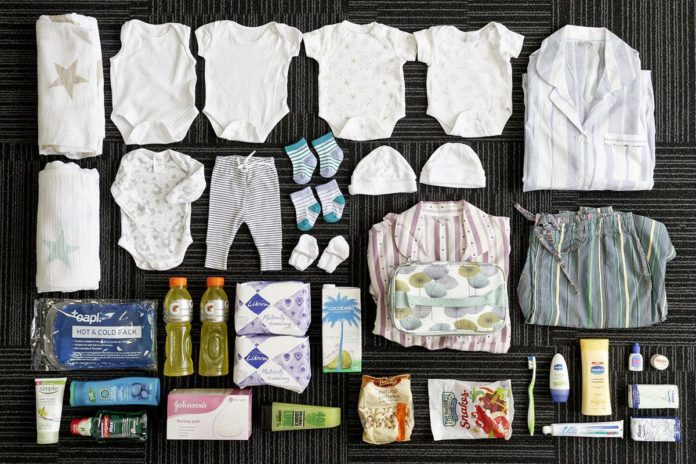DeliverLife — a new project from charity WaterAid — has revealed what women from around the globe pack in their maternity bags. The charity photographed and interviewed women internationally to find out what they packed.
From a razor blade to cut the umbilical cord to plastic sheets for the hospital bed; these photos show the startling contrast of birthing essentials around the world.
Ellen, 23, lives in Malawi

Image: WaterAid/ Jenny Lewis
What’s in the bag? Razor blade to cut the umbilical cord, torch as there is no electricity supply, black plastic sheet, to put on the delivery bed as, with no clean water, it’s hard to keep the delivery room and beds clean, string to tie the umbilical cord, 200 Malawian Kwacha note for food, three large sarongs for the mother to wear for their stay (which could be as long as four weeks) and to wrap the baby in.
Hazel Shandumba, 27, lives in Hamakando Village, Monze District, Zambia

Image: WaterAid/ Chileshe Chanda
What’s in the bag? Baby blanket, cotton wool, sarong (Chitenge), a baby suit, napkins, a dish for water to wash with, a polythene roll to put on the delivery bed to maintain personal hygiene as there is not enough water and time to clean the delivery bed.
“We have a borehole at the clinic but there is no running water in the maternity ward.”
Deanna Neiers, lives in New York City, U.S.A.

Image: WaterAid/ Deanna Neiers
What’s in the bag? Music player, coconut oil for massage, lavender oil, arnica gel, snacks, nursing bra and pads, nursing pillow, comfortable clothes to wear at the hospital and to travel back home, soft swaddle blanket for baby, a long-sleeve onesie, a knitted hat.
“Being pregnant certainly heightens your awareness of how fortunate we are to have access to great birthing facilities and clean water. You want the best for your baby and it’s devastating to think about dangers such as contaminated water and unhygienic facilities. I imagine a world where all women have a safe, clean place to birth their babies.”
Agnes Noti, 22, lives in Iramba District, Tanzania

Image: WaterAid/Anna Kari
What’s in the bag? Clothes for the baby, a cape (blanket) for the baby, socks, a basin, a flask, tea.
“I come from Tutu. The water for drinking, we buy from the shop. (Last time the other water came from) the river. There was white water. It was my grandmother who went to the river. The water from the river is not safe for drinking. So in the river many people fetch water that suffer. So using that one you can’t trust that water.”
Joanne Laurie, 34, London

What’s in the bag? Nappies, little white clothes for the baby, some knitted trousers, lots of snacks, my clothes, my own towel, toiletries, a tens machine, maternity pads, iPad, water bottle, medical notes, a blanket.
“I have packed a water bottle, my sister suggested to bring something to make it (water) easier to drink (during labour). I will bring it empty and I assuming the hospital will have somewhere I can fill it. They must have a water fountain. I am taking that for granted, unlike people in Africa. The most important thing in the bag is the blanket my mum gave me to bring the baby home in, the same one my mother brought me home in.”
Katy Shaw, 31, lives in Melbourne, Australia

Image: WaterAid/ James Grant
What’s in the bag? Toiletries, snacks, nappies, hat, socks, mittens, clothes and swaddles for the baby, clothes for me, night dresses, maternity underwear, maternity pads and nursing pads, massage oils
“I feel it is unbelievable that women are in that position (heavily pregnant women collecting dirty water themselves in the countries where WaterAid works), dealing with the everyday stresses of pregnancy and the prospect of childbirth, as well as the additional burden of collecting water.
“Even carrying the maternity bag is too heavy for me, I couldn’t imagine how I would cope if I had to carry 25litres of water over a distance. Physically I don’t know if I would be able to do it even before I was pregnant.”
Claudine Razafindrabary lives in Betafo district, Vakinankaratra region, Madagascar

What’s in the bag? New clothes, cotton wool, alcohol for cleaning, nappies, thermos, bucket, sanitary pads
“My family told me about the taboos around pregnancy and I’ve tried to follow them. For me, the main one is not putting a scarf around my neck during my pregnancy because if I do my baby could be born with the umbilical cord wrapped around their neck. So I don’t wear a scarf. I don’t even have one at home because I want my baby to be born naturally without anything around his neck.”
